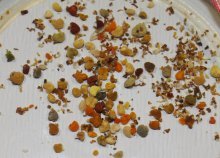June gap: evidence on the base board
My bee group talks about the 'June gap'. This is is the period where the spring flowers end and forage becomes scarce.
Many of the bee group are in rural areas of Oxfordshire where Oil Seed Rape is the primary crop. There are gardens and some hedgerows left, but their pickings are slim. In the city this is mostly not the case.
- Read more about June gap: evidence on the base board
- Log in or register to post comments
